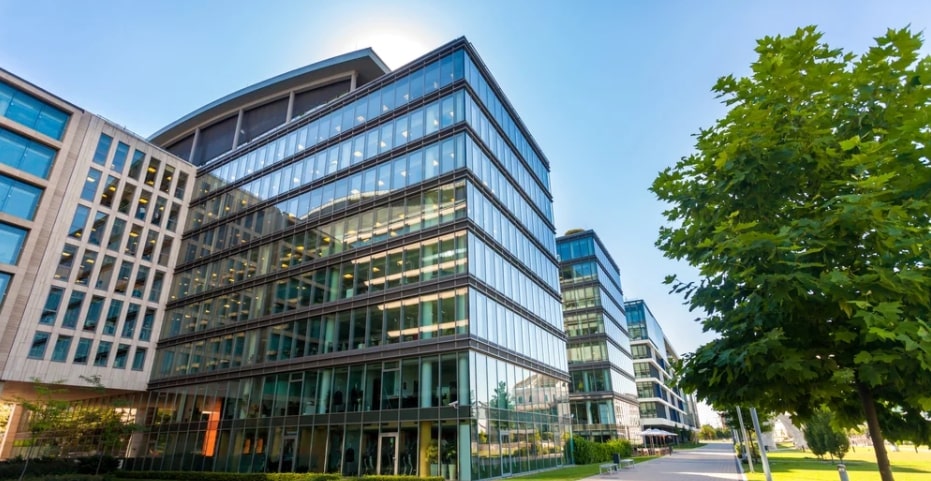The NYC Council pass the Climate Mobilization Act, as known as the NYC Green New Deal, in April 2019. The act included intro 1253, which aimed to add an emission limit to the greenhouse gases for buildings over 25,000 sq. ft. In May 2019, Intro 1253 became Local Law 97 (LL97) covering almost 60,000 buildings.
With respect to the emission levels in 2005, the emission reduction target for NYC buildings are 40% by 2030 and 80% by 2050. Initially, the limits were set for two periods: 2024 to 2029 and 2030 to 2034.
What Building Owners Need to Know About Local Law 97
· Starting 2025, all buildings applicable under LL97 must submit a yearly emissions report on May 1st.
· The emissions report must be stamped by a Registered Architect (RA) or a Professional Engineer (PE).
· A penalty of $268 will be applicable for ever tCO2e about the limit.
· The penalty for a not submitting the report is $0.50/sq. ft. per month, and the penalty for a false report is $50,000 and up to 30 days of imprisonment.
· The emission limits are in kilogram of CO2 equivalent, per sq. ft. and per year.
Can Building Owners Use Renewable Energy to Meet Local Law 97?
The short answer is Yes. Local Law 97 allows purchase of renewable energy credits & carbon offsets for meeting a part of the emissions target. Natural gas is one of the major electricity sources in NY representing about 40% of the total generation in the state according to the US Energy Information Administration. Since, solar power replaces electricity from power grid with clean energy, every kWh from the solar panels potentially replaces one kWh from a gas power station.
How Much Can the Emissions by Reduced with Solar Power?
Generally, a solar capacity of 15 watts can be fitted per sq. ft. of roof space. So essentially, a 20,000 sq. ft. can use a 300 kW solar array. Such a system is capable of generating over 420,000 kWh per year.
LL97 has an emissions factor of 0.000288962 tCO2eq / kWh. Considering the above example, the building emissions would be cut down by 121.36 metric tons per year. Since the penalty for exceeding the limit is $268 per ton, a building above the limit can avoid $32,526 in annual penalties.
According to the National Renewable Energy Laboratory, a 100 kW to 500kW solar system have an average price of $2.44/W in New York. This means a 300 kW system would cost around $732,000. This net price can be reduced to $541,680 with the help of 26% federal tax credit.
Considering an electricity price of 20 cents/kWh, a solar output of 420,000 kWh per year would save you $84,000. Going back a bit, we saw that the building is also saving $32,526 in LL97 penalties. This brings the total savings to $116,526 per year. Typically, a 300 kW solar power system has a payback period of 6.4 years based on the electricity savings alone. Combining this with avoided penalties, the payback period would be cut down to only 4.6 years. Keep in mind that solar panels have a life span of over 25 years.
How to Finance the Solar Installation and Pay the Loan with Savings?
Some companies can pay for a solar power system upfront, but this can impact the cash flow and lead to missed opportunities. Financing a solar power project with loan is a very attractive option since the savings can be used to pay off the loan. This is extremely helpful for commercial buildings. The building owners can be two types of savings: electricity savings and avoided penalties.
We saw that a 300 kW solar system would cost about $541,680 after considering the 26% federal tax credit. With 3% interest for a 10-year term, a $541,680 loan would result in $5,230.50 per month, or $62,766 per year. Since we already achieved a total savings of $116,526 per year, there is still much left as savings on the first year itself.
BONUS: How Much Space do Solar Panels Need?
Solar panels are manufactured in many sizes, but most of the installations use 60-cell or 72-cell modules. 60-cell panels are typically described as residential, and 72-cell panels are described as commercial. However, this isn’t a rule as 60-cell panels works just as intended in a commercial building, and 72-cell panels for residential.
The table below shows the typical area covered by each type of solar panel –
|
Solar Panel Type |
Dimensions |
Area |
|
60-cell |
5.42 ft x 3.25 ft |
17.6 sq. ft. |
|
72-cell |
6.42 ft x 3.25ft |
20.85 sq. ft. |
A 72-cell panel has a capacity of 20% higher than a 60-cell panels due to the additional cells. Due to this the number of panels can be reduced using 72-cell panels, which saves on racking, installation costs and efficient space usage.
Recommendations
Building emissions are calculated by referring to the energy consumption profile. This means, building owners must improve their energy efficiency to meet LL97. There are many measures that can save energy, but to find the optimal one that best suits the building requirement and system condition is a challenge.
The best recommendation is to start with an energy audit which will reveal the optimal energy efficiency measures after carefully and thoroughly inspecting the current building systems.

